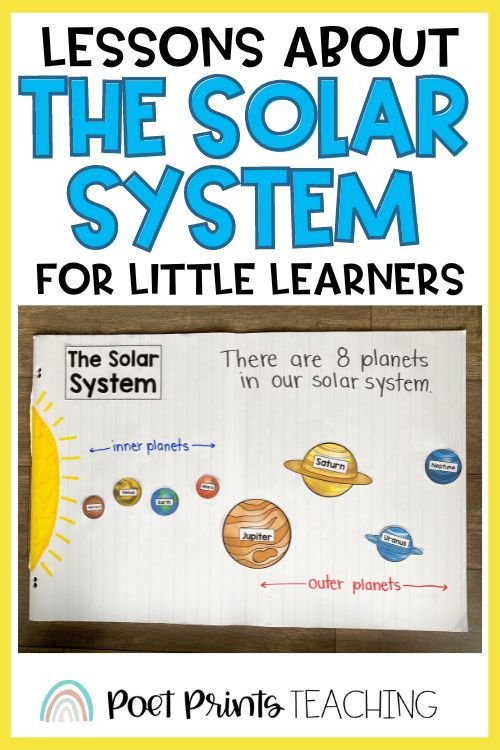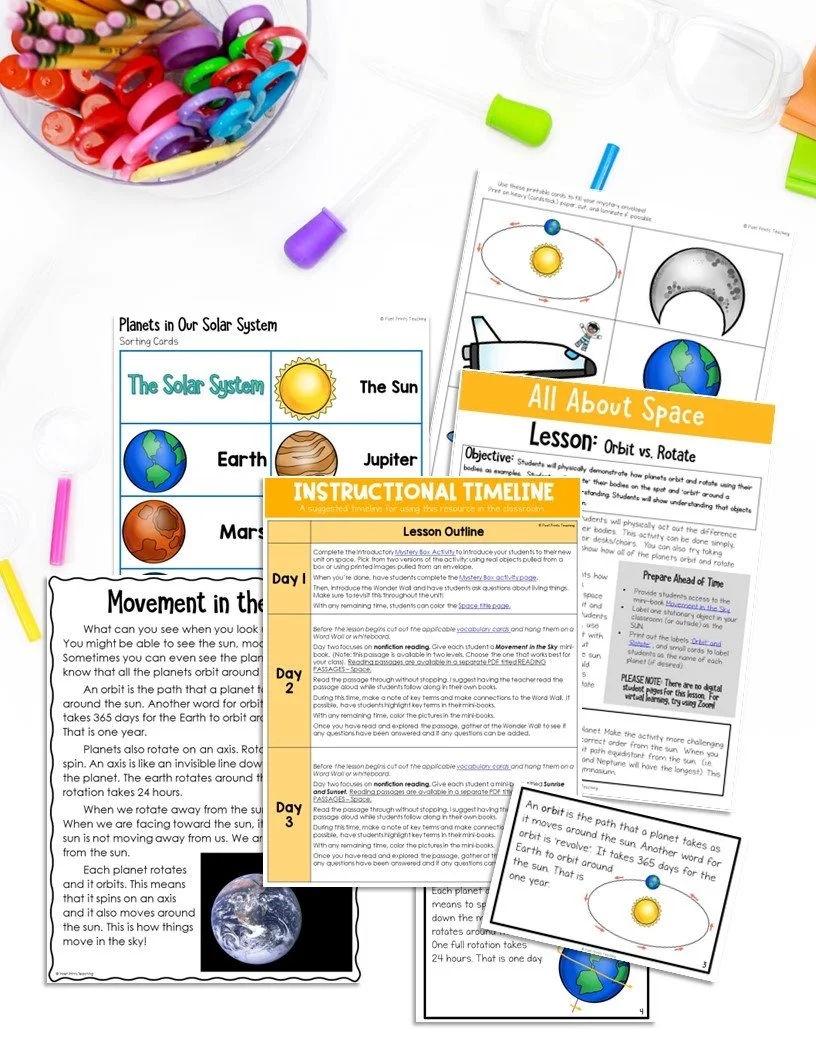Are you fascinated by planets in our solar system? I once had the opportunity to hear Chris Hadfield speak at a conference in Vancouver. Chris Hadfield is a Canadian astronaut who has been on several recent space expeditions to the International Space Station and he famously recreated the “Space Oddity” song while in space. I have always found the idea of space and space travel to be so inspiring. There is so much wonder and mystery in the universe. We can tap into that wonder while teaching about the Solar System. There are some great solar system activities, projects, and lessons that can be implemented into a unit about Space.
What is the Solar System for Kids?
Simply put, the Solar System is the Sun and everything that orbits around it. This includes the planets, the moons that orbit the planets, asteroids, comets, dust, gas, and other particles. Stars are not technically part of the Solar System.
The EASY Way to Teach the Solar System
Ready to start your unit on the Solar System in Kindergarten or First Grade? In just a few clicks you can grab all the pieces you need: lesson plans, vocabulary cards, nonfiction reading, printable worksheets ,and hands-on activities!
Click and print. Planning is really that easy.
Solar System and Space YouTube Videos
Here are some videos that you might want to use when teaching about the Solar System.
Sci Show Kids - Explore the Solar System: The Rocky Planets
Sci Show Kids - Why Can I See The Moon During the Day?
Story Bots - Outer Space - This one is a fun and engaging show geared toward young learners. This episode really gives me ‘Hamilton’ vibes with fast, rap-like lyrics.
The Planet Song for Kids - If you’re looking for a catchy song to teach your students to name the different planets, you might find this song fun.
What about Pluto? A great video about dwarf planets.
Astronauts in Space
Chris Hadfield created some fabulous videos about life in space that little learners would absolutely find interesting!
Canadian Space Agency - Chris Hadfield Brushes His Teeth in Space
Canadian Space Agency - Chris Hadfield’s Space Kitchen
Canadian Space Agency - Sleeping in Space
straw rocket stem challenge
Blast off with this STEM activity using common classroom materials. Use paper, a straw, glue, and pipe cleaners to create crafty rockets that launch using the power of your breath! They’re the perfect activity after watching the above videos about astronauts and space exploration. Full straw rocket instructions and supplies are here on the KiwiCo website.
Combining Reading and Art into Solar System Lessons
Add age-appropriate nonfiction reading about space with the passages in my Solar System Unit for little learners. Movement in the Sky explores how the planets orbit around the sun and rotate on their own axis. Sunrise and Sunset looks at how the movement of planets produces the sunrises and sunsets we see in the sky.
Go a step further with a sunrise/sunset art project! It’s a fun way to help students demonstrate their understanding of how the colors in the sky change during these times of day.
A sunrise or sunset art project with a black silhouette.
Before starting the project, read a story like ‘Sky Color’ by Peter H. Reynolds or watch an online video showing a sunrise or sunset. Using the book/video as a guide, talk about the colors that can be seen during a sunrise. Are they different in a sunset? How do they blend into each other? Which colors are found down low? Which ones are higher up. Give students painting materials (I like watercolors for this) and them time to paint and create.
Want to take it a step further? After the paint has dried, add a black silhouette of any shape/object you’d like. In the one pictured students added a landform (hill) and an animal of their choosing.
What’s the difference between Orbit and Rotate?
Learning the difference between orbit and rotation could become an interactive lesson by having students act each one out.
Make one student the sun
When you say “orbit” should walk around the sun in a circle, just like the planets orbit the sun
When you say “rotate” students should pause and spin in a circle on the spot. (Explain that they’re rotating on their own internal axis)
Of course, planets orbit and rotate, but this involves a little too much coordination for little learners! Feel free to try it out in a large space like a field or gymnasium.
The Planets in Our Solar System
Anchor Chart: The Solar System. Printable pieces for this chart are available in the Space and Solar System unit for littler learners.
Teaching the planets doesn’t have to be complicated. There are some intricate ideas out there like creating models of the solar system. This is a fun idea, but sometimes doing a multi-day project can be overwhelming, so I have a few ideas that require less prep to teach about the planets.
Create an anchor chart as a group to help students visualize the planets in space.
Put students into groups of eight and give each student a card with the name of a planet. Then have students organize themselves in the right order.
Cut and paste the planets into the correct order.
Learning about the Sun
The sun is vitally important to our Solar System. It is a source of light and heat. Everything rotates around it. It helps things grow. So it’s important to teach about the sun. For a fun lesson about the sun, have students learn some simple facts.
First, have students come up with things they know about the sun. Regardless of what they say, write these ideas down (yes, even if the idea is incorrect). Then have students do some research to learn more and determine if all the original statements about the sun were true.
Use the printable ‘All About the Sun’ worksheet to collect facts!
Space is vast, mysterious, and awe-inspiring! There are some fabulous activities to teach little learners all about space. How will you inspire your students while they learn about the Solar System?







